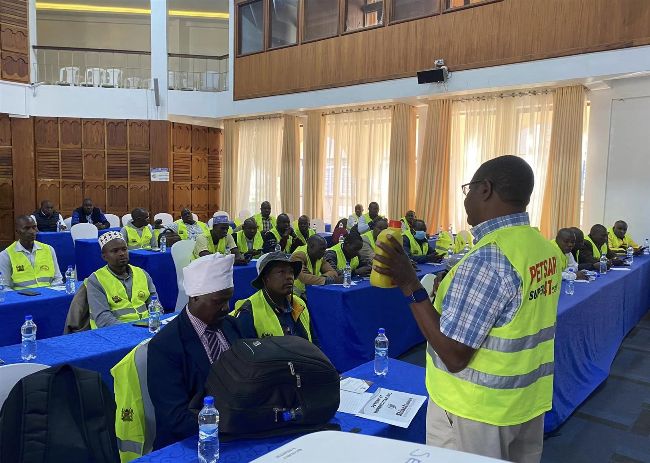LUBRICANTS
Challenges facing Kenya’s lubricant industry
The lubricant industry is very critical for the development of any economy. In modern life, lubricants are required, and the more sophisticated the equipment is, the more it demands a high-quality lubricant. It is usually said that “The lubricant is the blood of the economy.” If pure and applied correctly, it will propel the economy to prosperity. If it is of low quality, its effects are detrimental to the equipment and the economy.
By Mohamed Baraka, the Managing Director of Synergy Lubricants

A mechanic fixing a car.
SOURCE | SHUTTERSTOCK |ONI ABIMBOLA
T
he double-edged sword of substandard and counterfeit lubricants is a challenge that bedevils the Kenyan lubricants industry. In this article, we delve deep into the challenges that are crippling the lubricants industry in Kenya and highlight a small fraction of the amount of revenue lost in this industry due to these challenges.
A good-quality base oil is made by fractional distillation of crude oil, and distillation products are very pure. Agood-quality lubricant must use virgin base oil obtained by fractional distillation and blended with chemical additives whose performance has been tested in the intended equipment. A high-quality lubricant must also be made in a quality blending plant with a well-calibrated laboratory. Both blending and testing must be manned by qualified and experienced staff. The process that guarantees quality must be managed through written procedures.
>>Recycled base oils provide the feedstock for the production of counterfeit lubricants, which not only deny quality lube brand owners revenue but also damage machinery.
The country is seeing an increase in the use of recycled base oils. These base oils are produced in a simple process of filtration and decantation to remove solid contaminants in the used oil, and the resulting oil looks very much like virgin base oil. As this process is simple, the base oil obtained costs almost half the price of virgin base oil. This is the main ingredient in the substandard lubricants. These base oils are blended, repacked, and sold to unsuspecting users. In many cases, no additives are used, but even if they were used, they wouldn’t be effective as such additives might not be compatible with the contaminants in the recycled base oil.
These oils can easily damage machinery. They contain glycols from brake fluid and coolants, which catalyze them to thicken in service, especially since the antioxidant additives in the original oil are exhausted.

Mr. Baraka conducting a training during the boda boda association of Kenya chairmen and county reps meeting in Nairobi to sensitize them on the need to embrace proper lubrication for their motorcycles.
SOURCE | COURTESY
>> It is reckoned that the Kenyan economy could be losing over $4 billion per year through lubricant misapplication. This is about ten times the cost of lubricants used in Kenya annually.
Additionally, recycled base oils provide the feedstock for the production of counterfeit lubricants, which not only deny quality lube brand owners revenue but also damage machinery.
There is an existing standard in Kenya that prohibits the importation of recycled base oils, and it requires pre-shipment inspection, which means that the oil is tested at the source. When this was implemented, the importation of recycled base oils was drastically reduced. However, after some time, importers were given the option of destination inspection. This brought the challenge of THE Kenya Bureau of Standards (KEBS) being overwhelmed with all the testing they had to do, and consequently, some substandard goods slipped through the cracks and found their way into the Kenyan market. This has caused massive importation of recycled base oils in the country with a corresponding increase in counterfeit and damage to equipment.
To spur growth in the local manufacturing sector, the Kenyan government granted lubricant blenders the duty-free importation of base oil under the Duty Remission Scheme (DRS). While this was supposed to spur local manufacturing, create employment, reduce lubricant importation, make quality lubricants affordable to most users, and create wealth through exports, it has now created a loophole where blending facilities that are not to the standard are also given duty remissions and are importing recycled base oils while others are importing finished lubricants, which are declared as base oils.
Some of the finished lubricants imported under this disguise come packaged, so the benefit expected to be reaped by local package manufacturers has gone to zero, not to mention that employment in the industry is decreasing instead of increasing.
Through the DRS, there is a high likelihood that counterfeiting will increase tremendously as the volume being imported under DRS cannot all be sold in the importer’s brand. Most of it will be used for counterfeiting, and the level of coun-terfeiting is now at a magnitude never witnessed before. The exports might also be counterfeited, which has the potential of further ruining Kenya’s image in the export market and killing the little remaining export business.
The proliferation of calcium greases in the market is still a concern. A critical aspect of grease is its dropping point (melting point). Grease is base oil plus additives and thickener; the thickening material determines the melting point. Traditionally, greases used in chariots were animal fat plus calcium compounds. Calcium greases were used until the mid-1950s. They could not sustain the high temperatures generated by more advanced equipment because they have a dropping point of 100ºC and can be operated up to 60ºC, which is very low.
Relief came when lithium greases were discovered, catalyzing high-performing vehicles and machinery development. By the late 1960s, calcium greases were discontinued. About 30 years ago, calcium greases were banned in Kenya by introducing a grease standard that set the minimum dropping point of 160ºC. Sadly, calcium greases are still in the market; some have dropping points of as low as 90ºC. These greases require frequent re-greasing; if not done, the bearings fail and need replacement. Frequent re-greasing means more environmental damage, and we are equally wasting billions of shillings importing bearings to replace those that frequently fail.
Another major challenge in the market is fake or substandard radiator coolant. Using a basic rust and corrosion test, these coolants can be shown to be nothing more than water to which an appropriate dye has been added. Because they lack the necessary corrosion inhibitor additives, they damage the cooling system through rust and corrosion. Others even precipitate and clog the cooling ducts, resulting in overheating and engine damage. Kenya spends a lot of its hard-earned forex to import cooling system repair parts that could have been prevented by using quality coolants.
It is reckoned that the Kenyan economy could be losing over $4 billion per year through lubricant misapplication brought about by the challenges highlighted above. This is about ten times the cost of lubricants used in Kenya annually.